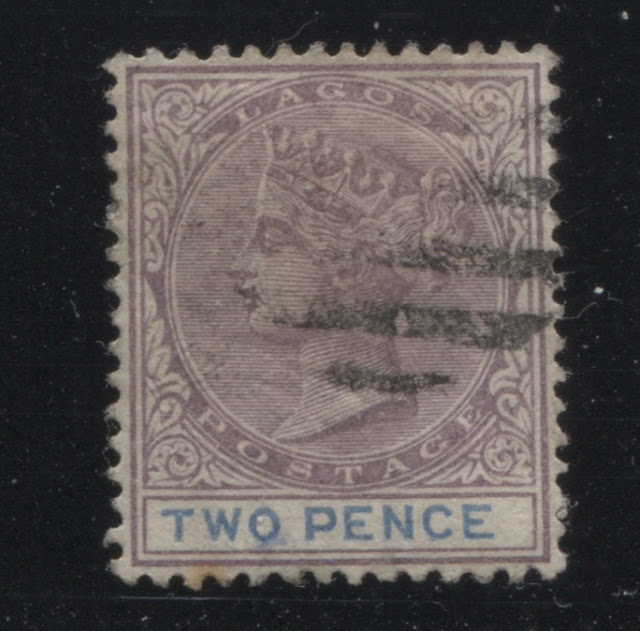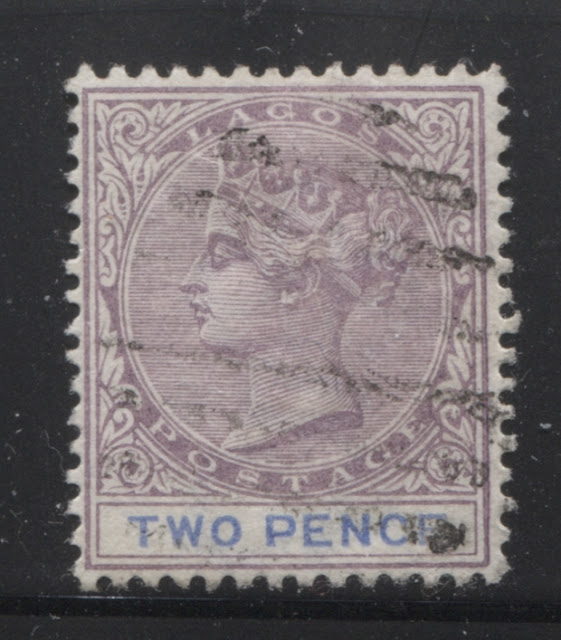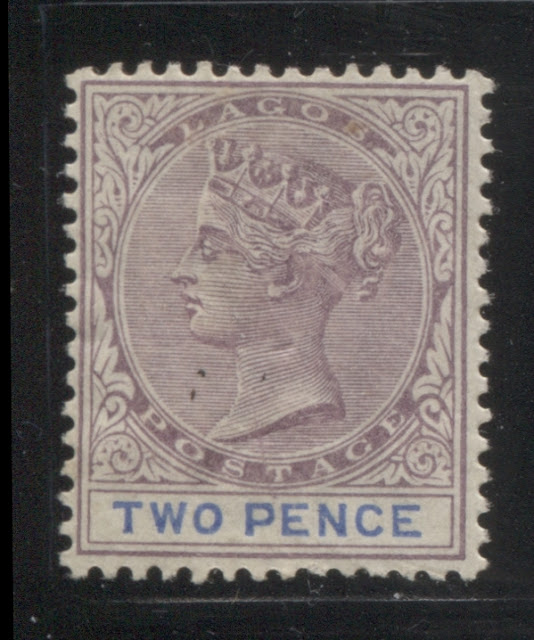Today's post continues my examination of the 2d lilac and ultramarine stamp of Lagos, and picks up where last week's post left off, at the twenty-eighth printing. This printing is the start of a group of printings from what I call the third state of the plate. In this state of the plate, there is a loss of overall sharpness, a loss of detail in the hair at the back of the head, and especially that below the diagonal ribbon, and merging of at least the top 5 hairlines on the head.
One of the shifts that we see in this group is the shift from mostly used examples to mostly mint, which makes sense given the very large number of remainders that were sent back to London in 1903. Also, this is the first group in which shades of ultramarine predominate for the duty plate colour, as opposed to shades of blue, grey blue and dull blue. The head plate colours are more dull purples and reddish lilacs, or very pale versions of these colours.
On the used stamps, barred ovals continue to dominate, though most of them are the thinner 9-bar types, which have begun to supplant the thicker 8-bar types.
Group 3: Printings from the Third State of the Plate - Printings 28 to 40 - About April 1894 to About April 1897.
Twenty Eighth Printing
On this printing, the head plate shade is similar to the twenty eighth printing above, but is much paler. So I would call this the pale dull plum shade. The duty plate colour is almost identical to the twenty eighth printing, being closest to Gibbons's blue shade.
Again, I have no used examples of this printing, but I do have four mint examples, all of which are shown above.
Thirtieth Printing
The head plate shade of this printing is closest to Gibbons's dull purple, but is maybe just slightly redder. The duty plate colour is similar to Gibbons's blue, but is paler.
This is the only printing in this group for which I have no mint examples. The used example shown above appears to be canceled with a 9-bar oval cancel, judging from the width of the bars, but it is difficult to be certain.
Thirty First Printing
On this printing, the head plate colour is closest to Gibbons' reddish lilac, but with just a slight hint of grey to the colour. The duty plate colour is closest to Gibbons's ultramarine, but is just a touch deeper.
I have a single mint example and one used example of this printing. The used example on the right is cancelled with a clear strike of a 9-bar oval.
Thirty Second Printing
The head plate colour of this printing is closest to Gibbons' dull purple, but a bit reddish. Again, the duty plate colour is closest to Gibbons's ultramarine, but maybe just a touch deeper.
I have no used examples of this printing, and only the sole mint example shown above.
Thirty Third Printing
On this printing, the head plate colour is an almost perfect match to Gibbons's dull purple. The duty plate colour is an almost perfect match to Gibbons's royal blue.
I have one mint example, and one used example of this printing. It is hard to be certain, but the used example appears to be cancelled with an 8-bar oval.
Thirty Fourth Printing
Thirty Fifth Printing
The head plate colour of this printing, once again, is closest to Gibbons's dull purple. The duty plate colour is a perfect match to Gibbons's ultramarine.
I have three mint and four used examples of this printing. All of the used examples appear to have been cancelled with strikes of a 9-bar oval obliterator.
Thirty Sixth Printing
On this printing, the head plate colour is closest to Gibbons's lilac, but duller. There is no dull lilac swatch on the Gibbons colour key, but I think this is how it would look if there was one. The duty plate colour is a very close match to Gibbons's deep ultramarine.
Here I have four mint examples and one used example, which has been cancelled with an 8-bar oval.
Thirty Seventh Printing
The head plate colour of this printing is closest to Gibbons's dull purple, but is much paler. So I would call the head plate shade of this printing, the pale dull purple. The duty plate colour of this printing is closest to Gibbons's royal blue.
Again, I have one mint, and one used example of this printing. The used stamp is cancelled with a Lagos CDS dated after 1899, through I can't make the date out clearly. But it would appear to be either a late usage of an intermediate printing, or it is the last printing actually made from this group, or one of the last ones.
Thirty Eighth Printing
One of the shifts that we see in this group is the shift from mostly used examples to mostly mint, which makes sense given the very large number of remainders that were sent back to London in 1903. Also, this is the first group in which shades of ultramarine predominate for the duty plate colour, as opposed to shades of blue, grey blue and dull blue. The head plate colours are more dull purples and reddish lilacs, or very pale versions of these colours.
On the used stamps, barred ovals continue to dominate, though most of them are the thinner 9-bar types, which have begun to supplant the thicker 8-bar types.
Group 3: Printings from the Third State of the Plate - Printings 28 to 40 - About April 1894 to About April 1897.
Twenty Eighth Printing
On this printing the head plate colour is closest to Gibbons's plum shade, but is just a touch duller. The duty plate colour is a perfect match to Gibbons's blue shade.
I have only the above single mint example, and no used examples of this printing.
Twenty Ninth Printing
On this printing, the head plate shade is similar to the twenty eighth printing above, but is much paler. So I would call this the pale dull plum shade. The duty plate colour is almost identical to the twenty eighth printing, being closest to Gibbons's blue shade.
Again, I have no used examples of this printing, but I do have four mint examples, all of which are shown above.
Thirtieth Printing
The head plate shade of this printing is closest to Gibbons's dull purple, but is maybe just slightly redder. The duty plate colour is similar to Gibbons's blue, but is paler.
This is the only printing in this group for which I have no mint examples. The used example shown above appears to be canceled with a 9-bar oval cancel, judging from the width of the bars, but it is difficult to be certain.
Thirty First Printing
On this printing, the head plate colour is closest to Gibbons' reddish lilac, but with just a slight hint of grey to the colour. The duty plate colour is closest to Gibbons's ultramarine, but is just a touch deeper.
I have a single mint example and one used example of this printing. The used example on the right is cancelled with a clear strike of a 9-bar oval.
Thirty Second Printing
The head plate colour of this printing is closest to Gibbons' dull purple, but a bit reddish. Again, the duty plate colour is closest to Gibbons's ultramarine, but maybe just a touch deeper.
I have no used examples of this printing, and only the sole mint example shown above.
Thirty Third Printing
On this printing, the head plate colour is an almost perfect match to Gibbons's dull purple. The duty plate colour is an almost perfect match to Gibbons's royal blue.
I have one mint example, and one used example of this printing. It is hard to be certain, but the used example appears to be cancelled with an 8-bar oval.
Thirty Fourth Printing
On this printing, the head plate colour is closest to Gibbons's reddish lilac. The duty plate colour is again closest to ultramarine.
I have only this single used example, which appears to have been cancelled with a 9-bar oval. This example shows the constant frame break under the "N" of "Pence".
Thirty Fifth Printing
The head plate colour of this printing, once again, is closest to Gibbons's dull purple. The duty plate colour is a perfect match to Gibbons's ultramarine.
I have three mint and four used examples of this printing. All of the used examples appear to have been cancelled with strikes of a 9-bar oval obliterator.
Thirty Sixth Printing
On this printing, the head plate colour is closest to Gibbons's lilac, but duller. There is no dull lilac swatch on the Gibbons colour key, but I think this is how it would look if there was one. The duty plate colour is a very close match to Gibbons's deep ultramarine.
Here I have four mint examples and one used example, which has been cancelled with an 8-bar oval.
Thirty Seventh Printing
The head plate colour of this printing is closest to Gibbons's dull purple, but is much paler. So I would call the head plate shade of this printing, the pale dull purple. The duty plate colour of this printing is closest to Gibbons's royal blue.
Again, I have one mint, and one used example of this printing. The used stamp is cancelled with a Lagos CDS dated after 1899, through I can't make the date out clearly. But it would appear to be either a late usage of an intermediate printing, or it is the last printing actually made from this group, or one of the last ones.
Thirty Eighth Printing
On this printing, the head plate colour is closest to Gibbons's reddish lilac, but is much, much paler. The duty plate colour is closest to Gibbons's dull ultramarine.
This is another printing for which I do not have any used examples.
Thirty Ninth Printing
On this printing, the head plate colour is closest to Gibbons's dull purple, but is reddish compared to the swatch on the Gibbons colour key. The duty plate colour is close to ultramarine, but it lacks the milkiness of ultramarine. Instead, it is closer to the royal blue shade, but is a bit paler.
I have only the above mint example of this printing, and no used examples.
Fortieth Printing
The head plate colour on this printing is closest to Gibbons 's reddish lilac, but is just a bit paler. The duty plate colour is identical to the thirty-ninth printing above, i.e. it is a slightly paler version of Gibbons's royal blue.
For this printing, I have one mint and one used example. Like the thirty seventh printing, the used stamp is also cancelled with a Lagos CDS dated sometime after 1900, which would seem to confirm its status as one of the last printings from this group.
This brings me to the end of my examination of this group of printings. My next post will cover the last printings made from the plate in its late states. I am having family from out of town next week, so I may or may not publish the next post before October 15, 2017. If I don't get to it until then, I would encourage my readers to review my last several posts in order to assimilate the information and become more comfortable with it in general.














